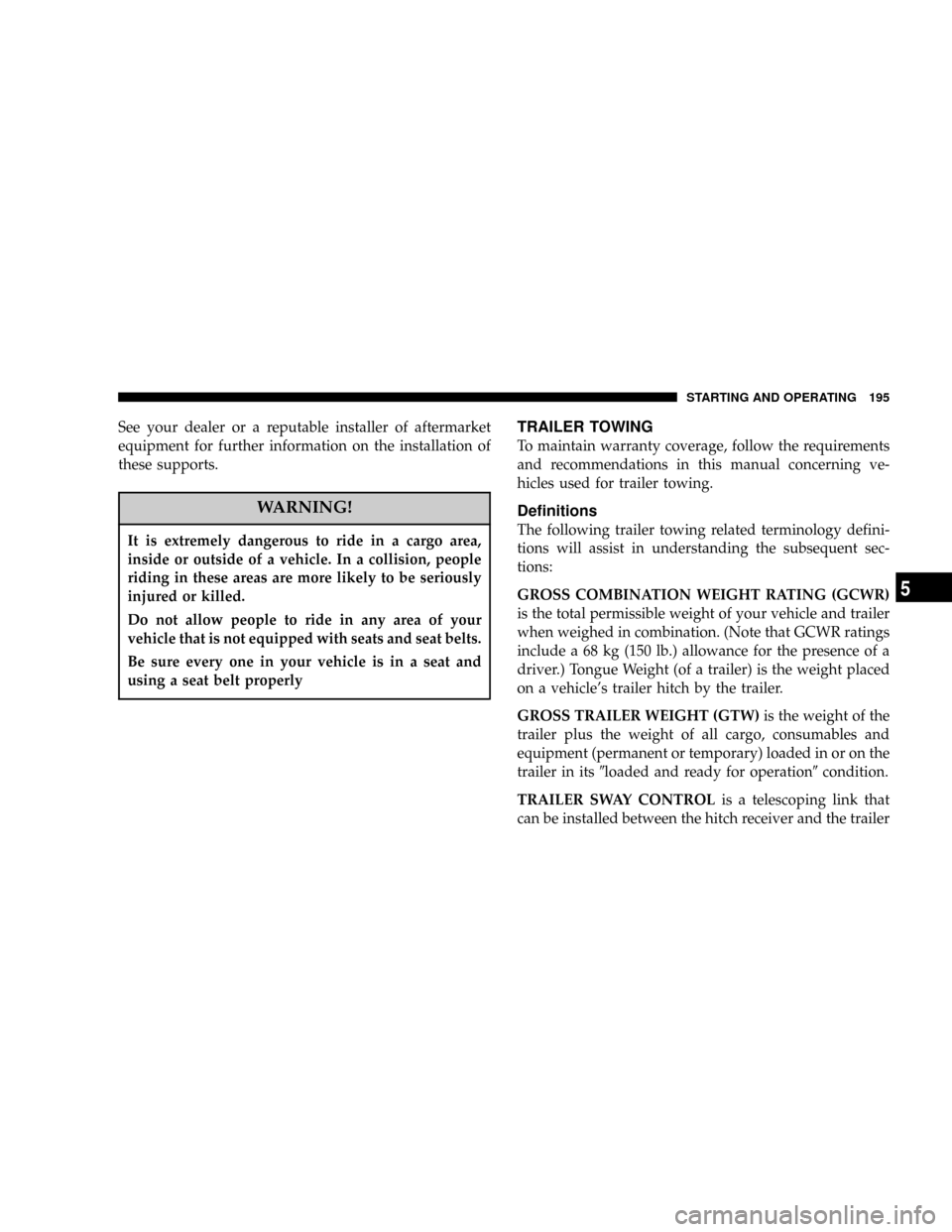2004 DODGE DAKOTA trailer
[x] Cancel search: trailerPage 99 of 300

INSTRUMENT CLUSTER DESCRIPTION
1. Engine Coolant Temperature Gage
The temperature gage indicates engine coolant
temperature. Any reading within the normal
range indicates that the cooling system is oper-
ating satisfactorily. The gage needle in V6 and V8
engines will likely indicate a high temperature when
driving in hot weather, up mountain grades, in heavy
traffic, or when towing a trailer. If the needle rises to
260É (hot mark), stop the vehicle, shift into N (Neutral)
and elevate engine speed for 2-3 minutes. If the
temperature reading does not return to normal, seek
authorized service immediately.
CAUTION!
Do not leave your vehicle unattended with the
engine running as you would not be able to react to
the temperature indicator if the engine overheats.
The gage pointer will remain near its last reading when
the engine is turned off. It will return to a true reading
when the engine is restarted.
2. Voltage Gage ± If Equipped
When the engine is running, the gage will
indicate the electrical system voltage. During
normal electrical load, the pointer will remain near the
center of the scale. If the pointer moves to either the
high or low sections, and remains there during normal
driving, the electrical system should be serviced.
3. Tachometer
This gage measures engine revolutions per minute (rpm
x 1000).
4. Shift Indicator Light
A small triangle lights to signal the most economical shift
point for vehicles equipped with a manual transmission.
See the Manual Transmission Operating description in
section 5 of this manual for details.
5. Turn Signal Indicators
When a turn signal is activated, a right-pointing or
left-pointing arrow lights up and flashes to indicate the
INSTRUMENT PANEL AND CONTROLS 99
4
Page 102 of 300

Temperature gages may not show accurate readings.
When the engine is not running, turn the ignition switch
to ON to obtain accurate readings.
17. Airbag Indicator
The indicator lights and remains lit for 6 to 8
seconds when the ignition is first turned ON. If
the light does not come on when the ignition is first
turned on, or the light stays on or comes on while
driving, have the airbag system checked by an autho-
rized dealer.
18. Low Fuel Warning Light
This indicator lights when the fuel gauge reads
1/8 of a tank or less.
19. ABS Warning Light
This light monitors the Anti-Lock Brake Sys-
tem which is described elsewhere in this
manual. This light will come on when the
ignition key is turned to the ON position and
may stay on for 5 seconds. If this light remains on or
comes on during driving, it indicates that the anti-lockportion of the brake system is not functioning and that
service is required. See your authorized dealer imme-
diately.
20. Transmission Oil Temperature Warning Light
This light indicates that there is excessive
transmission fluid temperature that might
occur with severe usage such as trailer tow-
ing. If this light comes on, stop the vehicle
and run the engine at idle or faster, with the transmis-
sion in NEUTRAL until the light goes off.
21. Security
The light will flash rapidly for approximately 15 seconds
when the vehicle theft alarm is arming. The light will
flash at a slower rate after the alarm is set. The security
light will also come on for about three seconds when the
ignition is first turned ON.
22. Cargo Lamp
The Cargo Lamp light will illuminate when the Cargo
Lamp is activated from the Head Lamp switch.
102 INSTRUMENT PANEL AND CONTROLS
Page 138 of 300

speeds will reduce fogging. Interior fogging on the
windshield can be quickly removed by selecting the
defrost mode.
Regular cleaning of the inside of the windows with a
non-filming cleaning solution (vinegar and water works
very well) will help prevent contaminates (cigarette
smoke, perfumes, etc.) from sticking to the windows.
Contaminates increase the rate of window fogging.
Summer Operation
Air conditioned vehicles must be protected with a high
quality antifreeze coolant during summer to provide
proper corrosion protection and to raise the boiling point
of the coolant for protection against overheating. A 50 %
concentration is recommended.When using the air conditioner in extremely heavy traffic
in hot weather especially when towing a trailer, addi-
tional engine cooling may be required. If this situation is
encountered, operate the transmission in a lower gear.
When stopped in heavy traffic, it may be necessary to
shift into NEUTRAL and depress the accelerator slightly
for fast idle operation.
Winter Operation
When operating the system during the winter months,
make sure the air intake, located directly in front of the
windshield, is free of ice, slush, snow, or other obstruc-
tions.
138 INSTRUMENT PANEL AND CONTROLS
Page 143 of 300

mLoading Wide Building Materials..........194
mTrailer Towing........................195
NDefinitions..........................195
NTrailer And Tongue Weight..............197
NTrailer TowingÐHitches................198
NTrailer Towing Information
(Maximum Trailer Weight Ratings).........199
NTrailer Towing Requirements.............199
NTrailer Tow Wiring....................200NCooling System TipsÐTrailer Towing.......201mSnowplow...........................201
NDodge Dakota Models..................201
mRecreational Towing (Behind Motorhome, Etc.)
Of 4X4 Vehicles
.......................202
NRecreational Towing Procedure............202
NReturning To Normal Operation...........204
mTraction.............................206
mEquipment Identification Plate............206
STARTING AND OPERATING 143
5
Page 149 of 300

The ªO/D OFFº feature must be selected, if desired, each
time the engine is started.
NOTE:If the vehicle is started in extremely cold
temperatures, the transmission may not shift into Over-
drive and will automatically select the most desirable
gear for operation at this temperature. Normal operation
will resume when the transmission fluid temperature has
risen to a suitable level. Refer also to the Note under
torque converter clutch, later in this section.
If the transmission temperature gets extremely hot, the
transmission will automatically select the most desir-
able gear for operation at this temperature. If the
transmission temperature becomes hot enough the
O/D OFF and/or TRANS TEMP light(s) may illumi-
nate and the transmission may downshift out of
Overdrive until the transmission cools down. After
cooldown, the transmission will resume normal op-
eration.
When To Lock Out Overdrive
When driving in hilly areas, towing a trailer, carrying a
heavy load, or whenever frequent transmission shifting
occurs, press the ªO/D OFFº button. This will improve
performance and reduce the potential for transmission
overheating or failure due to excessive shifting.
Torque Converter Clutch
A feature designed to improve fuel economy is included
in all automatic transmissions. A clutch within the torque
converter engages automatically at a calibrated speed at
light throttle. It engages at higher speeds under heavier
acceleration. This may result in a slightly different feeling
or response during normal operation in high gear. When
STARTING AND OPERATING 149
5
Page 173 of 300

adhere to the loading conditions, tire size and cold tire
inflation pressures specified on the Tire and Loading
Information placard and the Vehicle Loading section of
this manual.
NOTE:Under a maximum loaded vehicle condition,
gross axle weight ratings (GAWR's) for the front and rear
axles must not be exceeded. For further information on
GAWR's, vehicle loading and trailer towing, see the
Vehicle Loading section of this manual.
To determine the maximum loading conditions of your
vehicle, locate the statement ªThe combined weight of
occupants and cargo should never exceed XXX kg or XXX
lbs.º on the Tire and Loading Information placard. The
combined weight of occupants, cargo/luggage and
trailer tongue weight (if applicable) should never exceed
the weight referenced here.
Steps for Determining Correct Load Limit
1. Locate the statement ªThe combined weight of occu-
pants and cargo should never exceed XXX poundsº on
your vehicle's placard.
2. Determine the combined weight of the driver and
passengers that will be riding in your vehicle.3. Subtract the combined weight of the driver and pas-
sengers from XXX kilograms or XXX pounds.
4.
The resulting figure equals the available amount of cargo
and luggage load capacity. For example, if ªXXXº amount
equals 1400 lbs. and there will be five 150 lb. passengers in
your vehicle, the amount of available cargo and luggage
load capacity is 650 lb. (1400±750 (5 x 150) = 650 lb.)
5. Determine the combined weight of luggage and cargo
being loaded on the vehicle. That weight may not safely
exceed the available cargo and luggage load capacity
calculated in step 4.
6. If your vehicle will be towing a trailer, load from your
trailer will be transferred to your vehicle. Consult this
manual to determine how this reduces the available
cargo and luggage load capacity of your vehicle.
NOTE:The following table shows examples on how to
calculate total load, cargo/luggage and towing capacities
of your vehicle with varying seating configurations and
number and size of occupants. This table is for illustra-
tion purposes only and may not be accurate for the
seating and load carry capacity of your vehicle.
STARTING AND OPERATING 173
5
Page 195 of 300

See your dealer or a reputable installer of aftermarket
equipment for further information on the installation of
these supports.
WARNING!
It is extremely dangerous to ride in a cargo area,
inside or outside of a vehicle. In a collision, people
riding in these areas are more likely to be seriously
injured or killed.
Do not allow people to ride in any area of your
vehicle that is not equipped with seats and seat belts.
Be sure every one in your vehicle is in a seat and
using a seat belt properly
TRAILER TOWING
To maintain warranty coverage, follow the requirements
and recommendations in this manual concerning ve-
hicles used for trailer towing.
Definitions
The following trailer towing related terminology defini-
tions will assist in understanding the subsequent sec-
tions:
GROSS COMBINATION WEIGHT RATING (GCWR)
is the total permissible weight of your vehicle and trailer
when weighed in combination. (Note that GCWR ratings
include a 68 kg (150 lb.) allowance for the presence of a
driver.) Tongue Weight (of a trailer) is the weight placed
on a vehicle's trailer hitch by the trailer.
GROSS TRAILER WEIGHT (GTW)is the weight of the
trailer plus the weight of all cargo, consumables and
equipment (permanent or temporary) loaded in or on the
trailer in its9loaded and ready for operation9condition.
TRAILER SWAY CONTROLis a telescoping link that
can be installed between the hitch receiver and the trailer
STARTING AND OPERATING 195
5
Page 196 of 300

tongue that typically provides adjustable friction associ-
ated with the telescoping motion to dampen any un-
wanted trailer swaying motions while traveling.
CAUTION!
²During the first 500 miles (805 km) your new
vehicle is driven, do not tow a trailer. Doing so
may damage your vehicle.
²When first towing a trailer, limit your speed to 50
mph (80 km/h) during the first 500 miles (805 km)
of towing.
Consider the following items when computing the
weight on the rear axle:
²the tongue weight of the trailer
²the weight of any other type of cargo or equipment put
in or on your vehicle
NOTE:Remember that everything put into or on the
trailer adds to the load on your vehicle. Also, additional
factory-installed options, or dealer-installed options,
must be considered as part of the total load on your
vehicle. Refer to the Certification label located at the
driver's door for the Gross Vehicle Weight Rating.
Perform maintenance services as prescribed in the Main-
tenance Schedules section. When your vehicle is used for
trailer towing, never exceed the gross axle weight rating
(GAWR) and GVWR.
WARNING!
Improper towing can lead to an injury accident.
Follow these guidelines to make your trailer towing
as safe as possible:
²Be sure the trailer is loaded heavier in front, with 60%
to 65% of the weight located ahead of the trailer's
axles(s) sufficiently to place result in tongue weights of
between 10% and 15% of the GTW loaded trailer
weight on the tow hitch of your vehicle. (For a95th
196 STARTING AND OPERATING